The mayor of Hiroshima marked the anniversary of the world's first atomic bomb attack yesterday by lashing out at the US for its pursuit of next-generation nuclear weapons, and called on a global ban on all nuclear arms by 2020.
Denouncing US President George W. Bush's administration for its "egocentric" view of the world, Tadatoshi Akiba said Washington had turned its back on other nations.
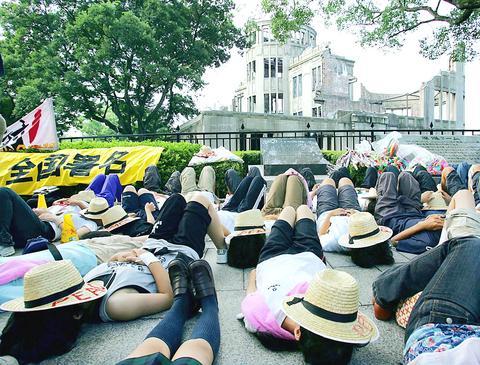
PHOTO: REUTERS
"Ignoring the UN and international law, the US has resumed research to make nuclear weapons smaller and more `usable,'" he said at the 59th annual ceremony in the western city's Peace Memorial Park.
In June, the US Senate approved spending for the Bush administration's research into -- but not development of -- new nuclear "bunker buster" and "mini-nuke" warheads.
The nuclear bunker buster would be designed to hit targets deep underground, such as subterranean military command centers that are beyond the reach of conventional arms.
The mini-nukes would have the explosive power of less than 5,000 tonnes of TNT -- one-fourth the size of the atomic bomb dropped on Hiroshima.
Supporters of the new weapons say they would cause less damage and fewer deaths in the area around a target.
The US has had a self-imposed ban on nuclear testing since 1992.
But Akiba said the world needs to dismantle and ban all weapons like the US atomic bomb that killed or injured 160,000 people on Aug. 6, 1945.
He called on nations to attend a nuclear nonproliferation meeting, to be held in May next year in New York, and sign a treaty that would eventually abolish nuclear arms by 2020.
He also branded North Korea's development of nuclear weapons a "worthless policy of `nuclear insurance.'" Japan, the US and four other nations have been engaged in recent talks to pressure the isolated communist regime to scrap its weapons program.
Before Akiba spoke, a bell pealed at 8:15am -- marking the time when the US A-bomb leveled this city, 687km southwest of Tokyo. Tens of thousands of survivors, residents, visitors and officials from around the world remembered the bombing victims by observing a minute of silence.
Afterward, 1,000 doves were released.
In brief remarks, Prime Minister Junichiro Koizumi reaffirmed Japan's policy banning the production, possession and transport of nuclear weapons within its borders.
Hiroshima city added to a list -- encased in a stone cenotaph -- 5,142 names of those who have died from cancer and other long-term ailments over the past year, raising the toll to 237,062, city official Niroaki Narukawa said.
Among those added in recent years were seven American POWs who perished in the explosion. Some of those Americans were from the crews of three aircraft -- two B-24 bombers and a Helldiver dive bomber -- shot down near Hiroshima on July 28, 1945 after a raid on Japanese warships in nearby Kure.
Others were prisoners who had been killed elsewhere in grisly experiments that the Japanese military apparently wanted to hide.
One American, US Army Air Force Corporal John Long, was newly incorporated earlier this year into a memorial hall in the peace park.
The park opened in 2002 and displays photographs and biographical notes about 9,000 bomb victims.
Ceremonies will be held Saturday on the anniversary of the atomic bombing of Nagasaki, on the southernmost main island of Kyushu.
About 70,000 people were killed by an atomic bomb dropped on Nagasaki from a US aircraft, three days after the one that hit Hiroshima.
On Aug. 15, 1945, Japan's surrender ended World War II.
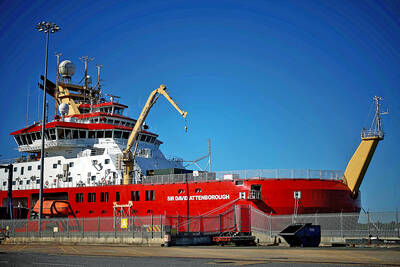
STEPPING UP: Diminished US polar science presence mean opportunities for the UK and other countries, although China or Russia might also fill that gap, a researcher said The UK’s flagship polar research vessel is to head to Antarctica next week to help advance dozens of climate change-linked science projects, as Western nations spearhead studies there while the US withdraws. The RRS Sir David Attenborough, a state-of-the-art ship named after the renowned British naturalist, would aid research on everything from “hunting underwater tsunamis” to tracking glacier melt and whale populations. Operated by the British Antarctic Survey (BAS), the country’s polar research institute, the 15,000-tonne icebreaker — boasting a helipad, and various laboratories and gadgetry — is pivotal to the UK’s efforts to assess climate change’s impact there. “The saying goes
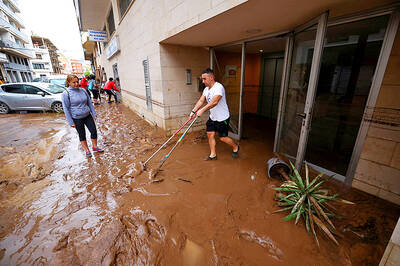
Floods on Sunday trapped people in vehicles and homes in Spain as torrential rain drenched the northeastern Catalonia region, a day after downpours unleashed travel chaos on the Mediterranean island of Ibiza. Local media shared videos of roaring torrents of brown water tearing through streets and submerging vehicles. National weather agency AEMET decreed the highest red alert in the province of Tarragona, warning of 180mm of rain in 12 hours in the Ebro River delta. Catalan fire service spokesman Oriol Corbella told reporters people had been caught by surprise, with people trapped “inside vehicles, in buildings, on ground floors.” Santa Barbara Mayor Josep Lluis
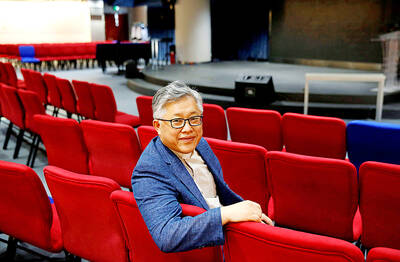
Police in China detained dozens of pastors of one of its largest underground churches over the weekend, a church spokesperson and relatives said, in the biggest crackdown on Christians since 2018. The detentions, which come amid renewed China-US tensions after Beijing dramatically expanded rare earth export controls last week, drew condemnation from US Secretary of State Marco Rubio, who on Sunday called for the immediate release of the pastors. Pastor Jin Mingri (金明日), founder of Zion Church, an unofficial “house church” not sanctioned by the Chinese government, was detained at his home in the southern city of Beihai on Friday evening, said
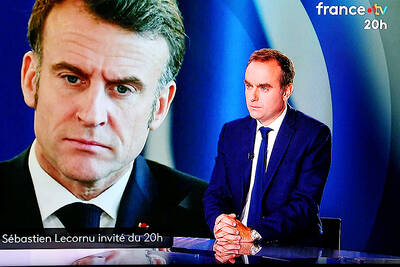
TICKING CLOCK: A path to a budget agreement was still possible, the president’s office said, as a debate on reversing an increase of the pension age carries on French President Emmanuel Macron yesterday was racing to find a new prime minister within a two-day deadline after the resignation of outgoing French Prime Minister Sebastien Lecornu tipped the country deeper into political crisis. The presidency late on Wednesday said that Macron would name a new prime minister within 48 hours, indicating that the appointment would come by this evening at the latest. Lecornu told French television in an interview that he expected a new prime minister to be named — rather than early legislative elections or Macron’s resignation — to resolve the crisis. The developments were the latest twists in three tumultuous